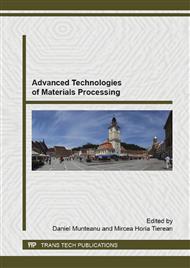[1]
H.D. Bao, Z.X. Guo, J. Yu, Effect of electrically inert particulate filler on electrical resistivity of polymer/multi-walled carbon nanotube composites. Polymer 49(17) (2008) 3826-3831.
DOI: 10.1016/j.polymer.2008.06.024
Google Scholar
[2]
W.X. Zhang, T.J. Wang, X. Chen, Effect of surface/interface stress on the plastic deformation of nanoporous materials and nanocomposites. Int. J. Plasticity 26 (2010) 957-975.
DOI: 10.1016/j.ijplas.2009.12.002
Google Scholar
[3]
S. Sathyanarayana, C. Hübner, Thermoplastic Nanocomposites with Carbon Nanotubes, J. Njuguna (ed. ), Structural Nanocomposites, Engineering Materials, Springer-Verlag Berlin Heidelberg, (2013).
DOI: 10.1007/978-3-642-40322-4_2
Google Scholar
[4]
M.F. Doerner, W.D. Nix, A method for interpreting the data from depth-sensing indentation instruments, J. Mater. Res. 1(4) (1986) 601–609.
DOI: 10.1557/jmr.1986.0601
Google Scholar
[5]
W.C. Oliver, G.M. Pharr, An improved technique for determining hardness and elastic modulus using load and displacement sensing indentation experiments, J. Mater. Res. 7(6) (1992) 1564–1583.
DOI: 10.1557/jmr.1992.1564
Google Scholar
[6]
G.M. Pharr, W.C. Oliver, Measurement of thin film mechanical properties using nanoindentation, MRS Bull. 17 (1992) 28-33.
DOI: 10.1557/s0883769400041634
Google Scholar
[7]
G.M. Pharr, Measurement of mechanical properties by ultra-low load indentation, Mater. Sci. Eng. A, 253 (1998) 151-159.
DOI: 10.1016/s0921-5093(98)00724-2
Google Scholar
[8]
A.C. Fischer-Cripps, Nanoindentation, 2nd ed., Springer, New York, (2004).
Google Scholar
[9]
J.L. Loubet, B.N. Lucas, W.C. Oliver, Some measurements of viscoelastic properties with the help of nanoindentation, NIST Special Publication 896: International Workshop on Instrumented Indentation, 1995, 31-34.
Google Scholar
[10]
B.N. Lucas, C.T. Rosenmayer, W.C. Oliver, Mechanical characterization of sub-micron polytetrafluoroethylene (PTFE) thin films, in Thin films-stresses and mechanical properties VII, Mater. Res. Soc. Symp. P. 505 (1998) 97-102.
DOI: 10.1557/proc-505-97
Google Scholar
[11]
W.C. Oliver, G.M. Pharr, Measurement of hardness and elastic modulus by instrumented indentation J. Mater. Res. 19(1) (2004) 3-20.
DOI: 10.1557/jmr.2004.19.1.3
Google Scholar
[12]
G.M. Pharr, A. Bolshakov, Understanding Nanoindentation Unloading Curves, J. Mater. Res. 17 (2002) 2660–2671.
DOI: 10.1557/jmr.2002.0386
Google Scholar
[13]
F. Stan, C. Fetecau, Characterization of viscoelastic properties of molybdenum disulphide filled polyamide by indentation, Mech. Time-Depend. Mater. 17 (2013) 205-221.
DOI: 10.1007/s11043-012-9198-5
Google Scholar
[14]
M.L. Oyen, R.F. Cook, Load–displacement behavior during sharp indentation of viscous–elastic–plastic materials, J. Mater. Res. 18 (2003) 139–150.
DOI: 10.1557/jmr.2003.0020
Google Scholar
[15]
A.E. Giannakopoulos, P.L. Larson, E. Soderlund, D.J. Rowcliffe, R. Vestergaard, Analysis of Vickers indentation, Int. J. Solids Struct. 31(19) (1994) 2679.
Google Scholar
[16]
** CSM Instruments: Investigation of creep behavior using Micro or Nano Indentation Tester (MHT/NHT), Applications Bulletin 22 (2006) 44-56.
Google Scholar
[17]
I.N. Sneddon, The relation between load and penetration in the axisymmetric Boussinesq problem for a punch of arbitrary profile, Int. J. Eng. Sci. 3 (1965) 47–57.
DOI: 10.1016/0020-7225(65)90019-4
Google Scholar
[18]
R.B. King, Elastic analysis of some punch problems for a layered medium, Int. J. Solids Struct. 23(12) (1987) 1657-1664.
DOI: 10.1016/0020-7683(87)90116-8
Google Scholar
[19]
F. Stan, L.I. Sandu, C. Fetecau, Effect of processing parameters and strain rate on mechanical properties of carbon nanotube–filled polypropylene nanocomposites, Composites: Part B 59 (2014) 109–122.
DOI: 10.1016/j.compositesb.2013.11.023
Google Scholar
[20]
T. Chudoba, F. Richter, Investigation of creep behaviour under load during indentation experiments and its influence on hardness and modulus results, Surf. Coat. Technol. 148 (2001) 191–198.
DOI: 10.1016/s0257-8972(01)01340-8
Google Scholar


